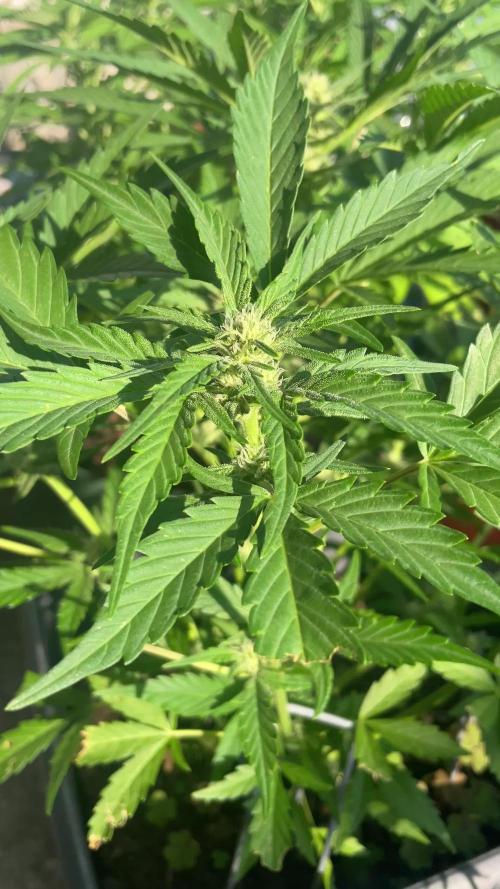The Grow Awards 2026 🏆 

























Processing
Likes
11
Share


@Crwfz1
Follow
Lots of training on all the girls this week all original sensible two gorilla glue one is the biggest under scrog already ghost is right behind then going to lay the last babby gorrilla across light range stay tuned
Likes
7
Share


@MrGrowthSpurt
Follow
What's up fellow growmies! I hope all is well with your grows!
This week progressed like usual, they actually are starting to pre-flower and growing stigmas. Its like clock work with these autos July 1st marked a complete year in growing and each time I've grown autos they always start to transition to flower in week 5/6.
Its hard to believe it has been a complete year for me💪🏾 I have gained so much knowledge and received so much help from this community and I really appreciate it. It seems like yesterday I was frantically worrying about everything. Although I have much to learn I think I pretty much have it down to a science. This last year I have grown 4 different strains 2 times each.
On my current grow I have stopped obsessing over watering, one thing I am learning is that watering until run off is not really needed, unless you want to test the ppm/ph of said run-off, otherwise you are just wasting water.
I start off with 1 liter of water per plant, and as they grow I make my way up to 2 liters. It appears to be the sweet spot especially for the 5 gallon pots, after about 2 liters I start to see run-off in the 3gallon pots I see it after about 1.5 liters of water.
I am still using the General Hydroponics Flora Series trio, it has worked well for me. I always mix what the manufacturer recommends per gallon into a 3 gallon sprayer, so I am giving 1/3rd of the recommended dosage out of fear of nute burn or lockout.
I performed LST on both Big Bud Auto plants, and one of my White Widows, the other 2 White Widows I am letting grow naturally.
Stay tuned and Happy Growing!!!! 🤘🏾🤙🏾💪🏾
Likes
41
Share


@DOOBS_N_BREWS
Follow
Started the week with a NFTG Mid flower feed. She's looking healthy and I shaved her legs a bit ;) definitely flowering and still stretching! almost 40 " or so as of right now =) Added a video of how I mix my NFTG solution
Day 71-NFTG mid flower feed /Mammoth P/ Recharge @ 6.5 ph
Day 72-73 No watering
Day 74- Recharge/Cal-Mag/Mammoth P/ Bloom Khaos Feed @6.5ph
Day 75- No water
Likes
69
Share


@Hempy_The_Kid
Follow
4/28/21 week 7 of veg 8 of life. Plant is getting to be a beast. Last week ended up topping more then I planned, and from the looks of things I will probably top at least one more time. I am going to up the nutrients to 550 ppm this week. I am also planning on giving recharge 2x per week. I am increasing irrigation to 4 gallons per. She is drinking about a gallon every 2.5 days.
4/29/21 gave final trim under canopy before flower cycle. Plant looks like a table 😃
4/30/21 I topped 4 more spots to keep my canopy even. I harvested my Super Skunk (you really need to try this strain) so now big Oggie has her own tent. For now she is under 1200w Growstar (250w actual) LED. She looks like she will engulf my tent.
5/1/21 gave 2 quarts recharge
5/2/21 backed nutrients down to 450ppm plant showing a little nute burn on a leaf.
5/3/21 set up self irrigating system. 8 gallons (holds max 14 gallons) water ph 6.01. With nutrients at 470ppm. Plant is now irrigating itself 2x per day 15 minutes each watering. Will be doing daily checks on ph/nutrients.
Likes
7
Share


@Dairon
Follow
Hola, aquí van creciendo despacito, pues las tengo en maceta de 0.6l aún, voy a usar otro armario que tengo para crecimiento, donde apartaré 8 critical x widow y las otras que andan por hay las 1024 y gorilla breath para seguirles dando crecimiento para más adelante, las 12 restantes las pasare a maceteros de 3l para que peguen un buen tirón, en el trasplante siempre agrego micorrizas y en el riego, solo Root Juice, con una pulverización de Acti Vera y Al a Mic para que lleven el estrés del trasplante mucho mejor, como se van a pegar bastante tiempo en crecimiento tengo que plantearme una alimentación con una EC baja, mientras florecen las satívas que tengo en el armario de floración (https://growdiaries.com/diaries/70839-jack-la-motta-llimonet-haze-classic-thc-grow-journal-by-dairon) manteniendo una rutina de prevencion con Leaf Coat, evitando la aparición de plagas y hongos, en las sucesivas semanas de crecimiento iré realizando podas para igualarlas en altura e intentar que tengan al menos cuatro ramas principales, veremos como avanza la cosa, Buenos humos!!!😃
Likes
25
Share


@Tonks
Follow
Sorry to be mushy, but thanks to everyone on here for the comments and support. Been a particularly shitty year and it's been so nice to escape on here now and then and focus on something we all love to do and share.
Likes
22
Share


@bypado_farm
Follow
Day 17:
They are growing well and healthy
Callmag foliar everyday when the lights are off
Day 19:
Watered each plant with 0.4L with nuts
827 ppm, 1759 us/cm, 1.7 EC
Day 22:
Watered each plant with 0.5L with nuts
1010 ppm, 2148 us/cm, 2.1 EC
Did some defoliation and lst aswell
Processing
Likes
10
Share


@JohnnyGrower
Follow
Esta semana los nutrientes siguen de la misma manera, es notorio el exceso de Nitrogeno por ende se disminuira en los próximos riegos, se realizaron podas apicales en los clones que no les hice anteriormente para que alcanzaran más altura. Dentro de esta semana instalare la malla scrog Kanovi para guiar los vigorosos brotes.
Además esta semana ya esta retomando el crecimiento la planta madre variedad Tangie la cual cumplió su ciclo de propagación por esquejes y porfin florecerá.
Leo comentarios, opiniones y recomendaciones
Likes
36
Share


@TaterheadJohnson
Follow
7/19: Started new nutrients today. Filled gallon jug with new nutes. Poured half of new nute mix in half gallon jug. Poured the entire half gallon jug into reservoir.
7/20: Bumped light intensity to 50%
7/21: Filled reservoir to the 2nd line today. Added a total of 1 gallon to res to get it to that line. Poured the rest of the mixed nutes for this week (half gallon) and then another half gallon of just plain water.
7/24: Bumped light intensity to 55%
7/25: Sadness today 😞.. While in the process of doing more LST today I accidentally snapped the main stem. I Panicked! Moved plant back in opposite direction to counteract the split. Will be monitoring very closely! 🙏🏾
***** For this Grow******
“Day Air Temperature” will be the max temp of tent for the week.
“Substrate Temperature” will be the average temp of tent for the week.
“Night Air Temperature” will be the lowest temp of the tent for the week.
Likes
27
Share


@Jgrowing420
Follow
Plants will be moved into tent next week and new ones gonna be set under the light without tent to maximize yield
Likes
46
Share


@MaryJaneUSA
Follow
Dudes, this girl is butt wild, she won’t stop growing. I had to defoliate her severally times over the course of 2 weeks. I am running out of growing space for her. She measures more than 2x2 (L x W). Drinks more than a gallon of water every 3-4 days. May need to invest in a RO system. However, I am very thankful that shes doing well. This is a GG#4 x Zkittlez by Cream of the crop seeds.
Likes
10
Share


@Fibro_Witch
Follow
Gave the photos a haircut today. Removed some fan leaves and lower branches that wouldn't amount to much. Gave the branches to my horse because he loves them! Tried enticing the ducks with fan leaves but they weren't having any of it. They prefer lettuce, not "The Devil's Lettuce"😂
I added in a little 5-1-1 fish fertilizer to my feeding regimen as well. Still picking off inchworms.
And as you can see I made it to the hardware store and put up this baby almost completely by myself. I only asked my husband to hold the center roof panel support while I screwed it in. Couldn't have been better timing since hurricane Dorian came through yesterday and we had plenty of rain. Of course it didn't fully protect them but the majority of the rain hit the roof. And then it got down to 49 F last night. It's really Fall now!
This girl is frosty and she ain't near done, those pistils are like a white walker! So looking forward to this finish, because it's gonna be better than last year for sure!
Likes
7
Share


@El_Bottanico
Follow
Somehow I counted weeks in a silly way, so I thought this was week 8 but it's still week 7. LoL.
Plant is doing great anyway,
She's big, exceeding 70 cm diameter, With so many colas at canopy level I expect her to yeld very big fo an Autoflowering strain,
The training succesfully shaped her resulting in 10 branch reaching the top canopoy level. To me the key to a good training is timing, much more than continuous adjustment. This plant was bent just one time on main stem and one another time little later the branches.
We had rainy days so I used a dehumidifier for a day or two, now it's dry again outside so no need for it anymore.
She's still thirsty like a bitch as she drinks 5 liters of water every two day. Maybe I'll make a drip sistem for my next grow, watering has been boring lately.
I'm not giving her anything to the end now, she's doing fine like this. The humus coupled with slow release fertilizer is doing a great job.
She has some nitrogen excess to me, but she's the only plant to show it in a batch of 6. The issue seems very small to me anyway.
Day 48 checked trichomes, some is turning milky already, can't wait for the buds to ripen :)
Ciao Bottanico































